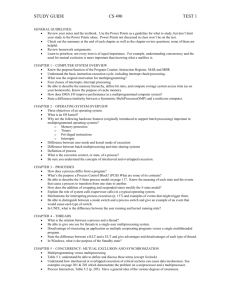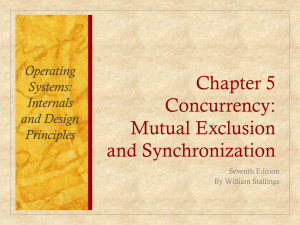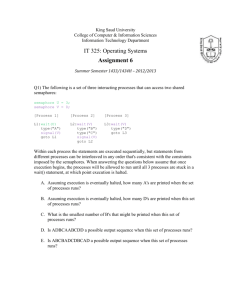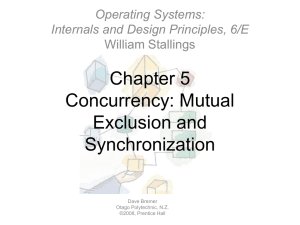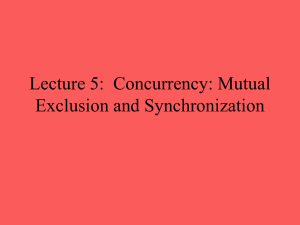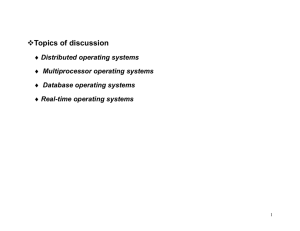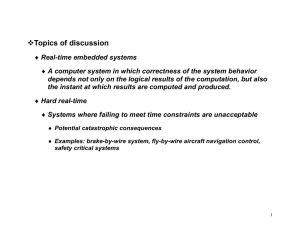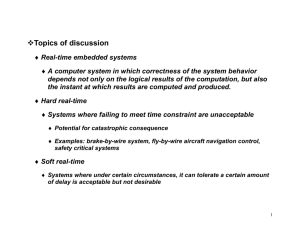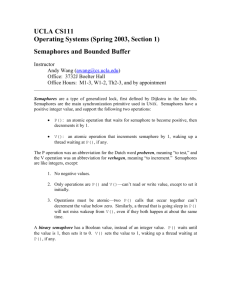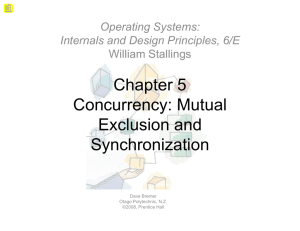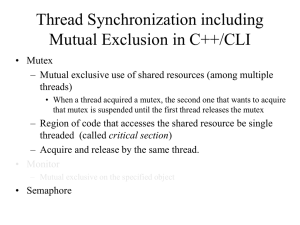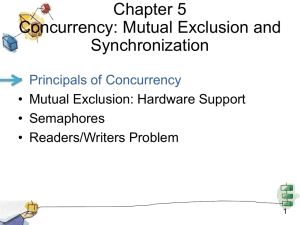Concurrency, Mutual Exclusion & Synchronization in OS
advertisement
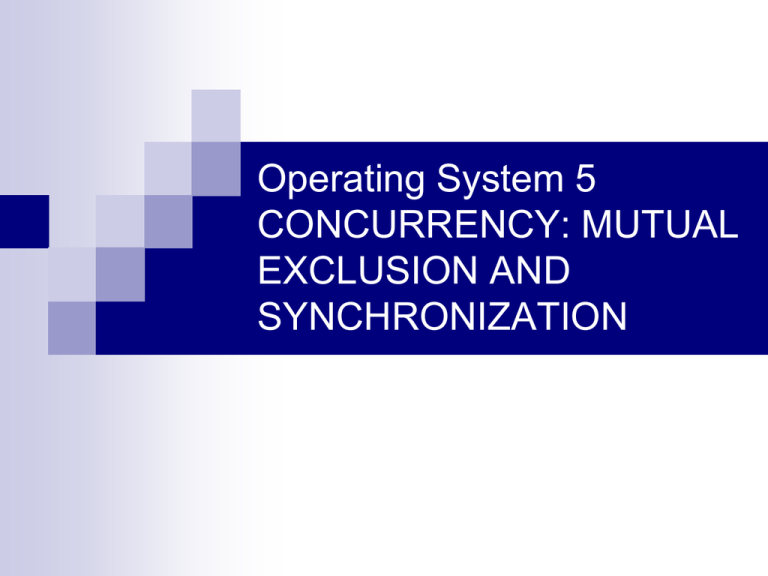
Operating System 5 CONCURRENCY: MUTUAL EXCLUSION AND SYNCHRONIZATION Design of processes management : and threads •Multiprogramming: The management of multiple processes within a uniprocessor system. •Multiprocessing: The management of multiple processes within a multiprocessor. •Distributed processing: The management of multiple processes executing on multiple, distributed computer systems.The recent proliferation of clusters is a prime example of this type of system. Fundamental to all of these areas, and fundamental to OS design, is concurrency. Concurrency arises in three different contexts: • Multiple applications • Structured applications • Operating system structure PRINCIPLES OF CONCURRENCY • • In a single-processor multiprogramming system, processes are interleaved in time to yield the appearance of simultaneous execution In a multiple-processor system, it is possible not only to interleave the execution of multiple processes but also to overlap them The following difficulties arise: 1. The sharing of global resources is fraught with peril 2. It is difficult for the OS to manage the allocation of resources optimally 3. It becomes very difficult to locate a programming error because results are typically not deterministic and reproducible Race Condition Example A race condition occurs when multiple processes or threads read and write data items so that the final result depends on the order of execution of instructions in the multiple processes. Let us consider two simple examples. As a first example, suppose that two processes, P1 and P2, share the global variable a. At some point in its execution, P1 updates a to the value 1, and at some point in its execution, P2 updates a to the value 2.Thus, the two tasks are in a race to write variable a. In this example the “loser” of the race (the process that updates last) determines the final value of a. For our second example, consider two process, P3 and P4, that share global variables b and c, with initial values b = 1 and c = 2. At some point in its execution, P3 executes the assignment b = b + c, and at some point in its execution, P4 executes the assignment c = b + c. Note that the two processes update different variables. However, the final values of the two variables depend on the order in which the two processes execute these two assignments. If P3 executes its assignment statement first, then the final values are b = 3 and c = 5. If P4 executes its assignment statement first, then the final values are b = 4 and c = 3. Operating System Concerns The OS must be able to keep track of the various processes The OS must allocate and deallocate various resources for each active process. The OS must protect the data and physical resources of each process against unintended interference by other processes. The functioning of a process, and the output it produces,must be independent of the speed at which its execution is carried out relative to the speed of other concurrent processes. Competition among Processes for Resources Cooperation by sharing Because data are held on resources (devices, memory), the control problems of mutual exclusion, deadlock, and starvation are again present.The only difference is that data items may be accessed in two different modes, reading and writing, and only writing operations must be mutually exclusive. However, over and above these problems, a new requirement is introduced: that of data coherence. Let Cooperation among Processes by Communication •In the first two cases that we have discussed, each process has its own isolated environment that does not include the other processes. The interactions among processes are indirect. •In both cases, there is a sharing. In the case of competition, they are sharing resources without being aware of the other processes. In the second case, they are sharing values, and although each process is not explicitly aware of the other processes, it is aware of the need to maintain data integrity. •When processes cooperate by communication, however, the various processes participate in a common effort that links all of the processes.The communication provides a way to synchronize, or coordinate, the various activities. Requirements for Mutual Exclusion: 1. 2. 3. 4. 5. 6. Mutual exclusion must be enforced:Only one process at a time is allowed into its critical section, among all processes that have critical sections for the same resource or shared object. A process that halts in its noncritical section must do so without interfering with other processes. It must not be possible for a process requiring access to a critical section to be delayed indefinitely: no deadlock or starvation. When no process is in a critical section, any process that requests entry to its critical section must be permitted to enter without delay. No assumptions are made about relative process speeds or number of processors. A process remains inside its critical section for a finite time only. There are a number of ways in which the requirements for mutual exclusion can be satisfied. 1. Leave the responsibility with the processes that wish to execute concurrently 2. Involves the use of special-purpose machine instructions 3. Provide some level of support within the OS or a programming language. MUTUAL EXCLUSION: HARDWARE SUPPORT Interrupt Disabling In a uniprocessor system, concurrent processes cannot have overlapped execution; they can only be interleaved. Furthermore, a process will continue to run until it invokes an OS service or until it is interrupted. Therefore, to guarantee mutual exclusion, it is sufficient to prevent a process from being interrupted. this approach will not work in a multiprocessor architecture. Special Machine Instructions At the hardware level, access to a memory location exludes any other access to that same location.With this as a foundation, processor designers have proposed several machine instructions that carry out two actions atomically, such as reading and writing or reading and testing. Compare&Swap Instruction The compare&swap instruction, also called a compare and exchange instruction. Exchange Instruction The use of a special machine instruction to enforce mutual exclusion has a number of advantages: • It is applicable to any number of processes on either a single processor or multiple processors sharing main memory. • It is simple and therefore easy to verify. • It can be used to support multiple critical sections; each critical section can be defined by its own variable There are some serious disadvantages: • Busy waiting is employed. Thus, while a process is waiting for access to a critical section, it continues to consume processor time. • Starvation is possible. When a process leaves a critical section and more than one process is waiting, the selection of a waiting process is arbitrary. Thus, some process could indefinitely be denied access. • Deadlock is possible. Consider the following scenario on a single-processor system. Process P1 executes the special instruction (e.g., compare&swap, exchange) and enters its critical section. P1 is then interrupted to give the processor to P2, which has higher priority. If P2 now attempts to use the same resource as P1, it will be denied access because of the mutual exclusion mechanism. Thus it will go into a busy waiting loop. However, P1 will never be dispatched because it is of lower priority than another ready process, P2. SEMAPHORES We now turn to OS and programming language mechanisms that are used to provide concurrency. Table 5.3 summarizes mechanisms in common use.We begin, The fundamental principle is this: Two or more processes can cooperate by means of simple signals, such that a process can be forced to stop at a specified place until it has received a specific signal. Any complex coordination requirement can besatisfied by the appropriate structure of signals. For signaling, special variables called semaphores are used. To transmit a signal via semaphore s, a process executes the primitive semSignal(s).To receive a signal via semaphore s, a process executes the primitive semWait(s); if the corresponding signal has not yet been transmitted, the process is suspended until the transmission takes place. To achieve the desired effect,we can view the semaphore as a variable that has an integer value upon which only three operations are defined: 1. A semaphore may be initialized to a nonnegative integer value. 2. The semWait operation decrements the semaphore value. If the value becomes negative, then the process executing the semWait is blocked. Otherwise, the process continues execution. 3. The semSignal operation increments the semaphore value. If the resulting value is less than or equal to zero, then a process blocked by a semWait operation, if any, is unblocked. In principle, it should be easier to implement the binary semaphore, and it can be shown that it has the same expressive power as the general semaphore (see Problem 5.17). To contrast the two types of semaphores, the nonbinary semaphore is often referred to as either a counting semaphore or a general semaphore. A concept related to the binary semaphore is the mutex. A key difference between the two is that the process that locks the mutex (sets the value to zero) must be the one to unlock it (sets the value to 1). In contrast, it is possible for one process to lock a binary semaphore and for another to unlock it. For both counting semaphores and binary semaphores, a queue is used to hold processes waiting on the semaphore. The question arises of the order in which processes are removed from such a queue. The fairest removal policy is first-infirst-out (FIFO):The process that has been blocked the longest is released from the queue first; a semaphore whose definition includes this policy is called a strong semaphore. A semaphore that does not specify the order in whic Semaphores provide a primitive yet powerful and flexible tool for enforcing mutual exclusion and for coordinating processes. However, as Figure 5.9 suggests, it may be difficult to produce a correct program using semaphores. The difficulty is that semWait and semSignal operations may be scattered throughout a program and it is not easy to see the overall effect of these operations on the semaphores they affect. The monitor is a programming-language construct that provides equivalent functionality to that of semaphores and that is easier to control. The monitor construct has been implementedin a number of programming langu ages, including Concurrent Pascal, PascalPlus,Modula-2, Modula-3, and Java. It has also been implemented as a program library. MONITORS Monitor with Signal A monitor is a software module consisting of one or more procedures, an initialization sequence, and local data.The chief characteristics of a monitor are the following: 1. The local data variables are accessible only by the monitor’s procedures 2. A process enters the monitor by invoking one of its procedures. 3. Only one process may be executing in the monitor at a time; any other processes that have invoked the monitor are blocked, waiting for the monitor to become available. The first two characteristics are reminiscent of those for objects in object-oriented software. By enforcing the discipline of one process at a time, the monitor is able to provide a mutual exclusion facility. To be useful for concurrent processing, the monitor must include synchronization tools. A monitor supports synchronization by the use of condition variables that are contained within the monitor and accessible only within the monitor. Alternate Model of Monitors with Notify and Broadcast Hoare’s definition of monitors [HOAR74] requires that if there is at least one process in a condition queue, a process from that queue runs immediately when another process issues a csignal for that condition. Lampson and Redell developed a different definition of monitors for the language Mesa [LAMP80].Their approach overcomes the problems just listed and supports several useful extensions. Synchronization Consider the send primitive first. Similarly, when a process issues a receive primitive, there are two possibilities: 1. If a message has previously been sent, the message is received and execution continues. 2. If there is no waiting message, then either (a) the process is blocked until a message arrives, or (b) the process continues to execute, abandoning the attempt to receive. Queuing Discipline The simplest queuing discipline is first-in-firstout, but this may not be sufficient if some messages are more urgent than others. Mutual Exclusion This approach is quite flexible. There may be multiple producers and consumers, as long as all have access to both mailboxes. READERS/WRITERS PROBLEM READERS/WRITERS PROBLEM The readers/writers problem is defined as follows:There is a data area shared among a number of processes.The data area could be a file, a block of main memory, or even a bank of processor registers. There are a number of processes that only read the data area (readers) and a number that only write to the data area (writers).The conditions that must be satisfied are as follows: 1. Any number of readers may simultaneously read the file. 2. Only one writer at a time may write to the file. 3. If a writer is writing to the file, no reader may read it. Before proceeding, let us distinguish this problem from two others: the general mutual exclusion problem and the producer/consumer problem. Can the producer/consumer problem be considered simply a special case of the readers/writers problem with a single writer (the producer) and a single reader (the consumer)? The answer is no. The producer is not just a writer. Similarly, the consumer is not just a reader, because it must adjust the queue pointer. Selesai....
